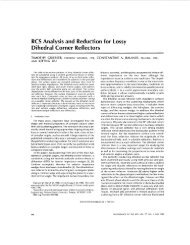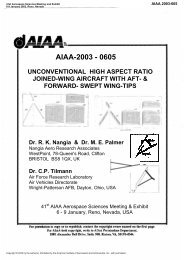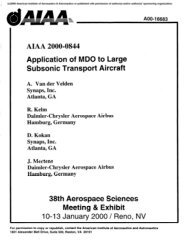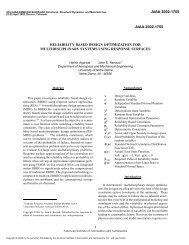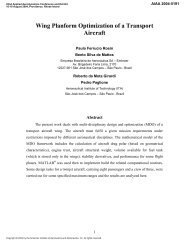The design report
The design report
The design report
You also want an ePaper? Increase the reach of your titles
YUMPU automatically turns print PDFs into web optimized ePapers that Google loves.
Another issue which attributed to the malfunction of the landing gear was the right<br />
wheel itself. <strong>The</strong> wheels were all scavenged from the wreckage of previous planes as<br />
new wheels were not supplied. This led to some difficulty in finding wheels of adequate<br />
quality. As a result of this, the wheel used for the right nose landing gear was slightly<br />
faulty, as the groove inside was uneven.<br />
Another potential problem associated with the landing gear was the load the nose gear<br />
was being subject to. It was stated that the nose gear should take no more than 6-15%<br />
of the weight of the aircraft. However, this fact was for a single nose gear. As iSpy<br />
possessed twin nose gear, it was assumed that it could withstand double the weight of a<br />
single nose gear. Thus the nose gear was subject to 25% of the load. This was a very<br />
high percentage of the load, and the idea that it could withstand this much was based<br />
simply on an assumption. Thus the possibly excess load, coupled with the faulty wheel<br />
meant that extra force was placed on a steel rod which was already slightly bent out of<br />
shape.<br />
Other than this landing gear issue, the first ground test was deemed to be an overall<br />
success. <strong>The</strong> controls and wiring were all in excellent working condition, and the plane<br />
was able, despite complications, to maneuver and taxi well.<br />
Ground Test 2 6.1.2<br />
This second ground test was not a part of the course plan, and was made necessary due<br />
to the disastrous events which occurred several hours after ground test 1. When testing<br />
the engines later on the day of the first ground test, it was discovered that both ESCs<br />
had somehow burnt out, and needed to be replaced. This meant that new ESCs had to be<br />
prepared and attached in the place of the old ones. Once the new ESCs had been<br />
installed, the team deemed it necessary to perform a subsequent ground test to check<br />
that the new ESCs were working. Hence, ground test 2 took place on Tuesday the fifth of<br />
January, 2009.<br />
Ground test 2 was conducted in a similar manner to ground test 1. <strong>The</strong> controls and<br />
motors were checked first while the aircraft was stationary. <strong>The</strong>n the vehicle was<br />
guided through an array of maneuvers. <strong>The</strong> new ESCs proved to be in excellent working<br />
condition, and the controls and engines all worked resoundingly well, although with the<br />
lingering problem of the left engine. <strong>The</strong> landing gear had by this stage been<br />
disassembled and re-formed, and the aircraft was able to perform admirably.








![Introduction to RF Stealth [Book Review] - Antennas and ...](https://img.yumpu.com/16857890/1/190x245/introduction-to-rf-stealth-book-review-antennas-and-.jpg?quality=85)

